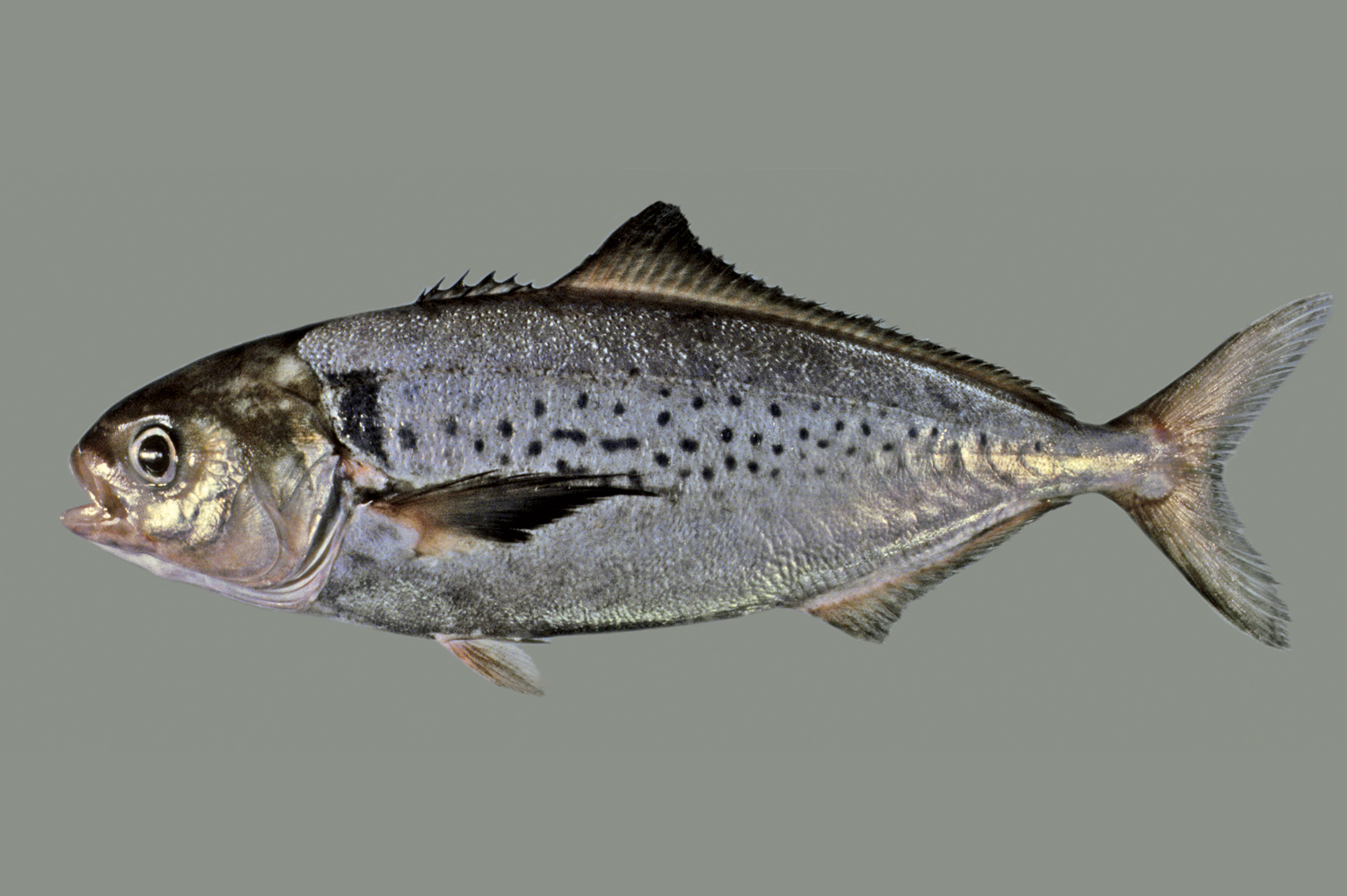Silver Warehou, Seriolella punctata (Forster 1801)
Other Names: Blue Bass, Mackerel Snotgall, Mackerel Trevalla, Patagonian Silver Trevalla, Snottynose Trevally, Spotted Trevalla, Spotted Warehou, Spotty Nose Trevally

Silver Warehou, Seriolella punctata. Source: Rudie H. Kuiter / Aquatic Photographics. License: All rights reserved
Summary:
An almost metallic silvery-blue to grey warehou becoming paler on the sides and silvery-white below, with a dark blotch above the pectoral-fin base and a darker greyish-blue 'mask' on the top part of the head and around the snout and eyes. Juveniles have an irregular series of small dark spots along the sides.
Cite this page as:
Bray, D.J. 2018, Seriolella punctata in Fishes of Australia, accessed 19 Apr 2024, https://fishesofaustralia.net.au/home/species/2924
Silver Warehou, Seriolella punctata (Forster 1801)
More Info
|
Distribution |
Off Port Stephens, New South Wales, to the Gulf St Vincent, South Australia, and off Tasmania. Elsewhere the species occurs in New Zealand, the western Atlantic, southeastern Pacific and subantarctic islands. Adults are bethopelagic in deeper offshore water to a depth of 650 m. Small juveniles are pelagic. As the grow, older juveniles move inshore and may be found in bays and inlets. |
|
Features |
Dorsal fin VII-IX, 35-39; Anal fin III, 21-24; Caudal fin 17; Pectoral fin 19-22; Pelvic fin I, 5; Lateral line scales ~110-120; Gill rakers 5-7 + 1 + 14; Vertebrae 25. Body streamlined, moderately shallow (27-33% SL), compressed; caudal peduncle slender, without lateral keels. Head of moderate size (26-31% SL); snout pointed; eyes small (14-23% HL); mouth small, maxillae reaching below front of eyes, slightly oblique; teeth fine, single row in each jaw. Pyloric caeca few and finger like. Scales very small and easily dislodged, anterior scale limits on nape with distinct fleshy margin forming pointed 'mask'; lateral line curved, about parallel to profile of back. Head and trunk covered with numerous small pores. Two dorsal fins, first dorsal with origin above pectoral fin bases, having short stout spines, connected by membrane to base of second dorsal, second dorsal fin much higher, anterior fin rays longest, outer margin deeply concave; anal fin similar to and opposite second dorsal; caudal fin deeply forked. Pectoral fins of moderate size, not reaching to anus, moderately falcate. Pelvic fins of moderate size, thoracic. |
|
Colour |
Silvery blue to grey on back, almost metallic, paling somewhat on sides, silvery white on belly; head darker grey brown above and around snout and around eyes, creating a 'mask'; dark blotch above each pectoral fin base, followed in small examples by irregular lateral series of small dark spots which are lost in large individuals. |
|
Feeding |
Feeds mostly on pelagic invertebrates such as pyrosomes and other tunicates. |
|
Biology |
A schooling species that forms aggregations near the seafloor to feed and spawn. Individuals mature at about 4 years of age, and spawn during late winter to early spring. Females produce up to about 1.6 million eggs per spawning season. |
|
Remarks |
A valuable food fish mostly taken by trawl, although some non-trawl (gillnet) catches occur. |
|
Species Citation |
Scomber punctatus Forster, in Bloch & Schneider 1801, Systema Ichthyologiae: 37. Type locality: New Zealand. |
|
Author |
Bray, D.J. 2018 |
|
Resources |
Silver Warehou, Seriolella punctata (Forster 1801)
References
Bruce, B.D., Neira, F.J. & Bradford, R.W. 2001. Larval distribution and abundance of blue and spotted warehous (Seriolella brama and S. punctata: Centrolophidae) in south-eastern Australia. Marine and Freshwater Research 52(4): 631-636
Castelnau, F.L. de 1872. Contribution to the ichthyology of Australia. 1. The Melbourne fish market. Proceedings of the Zoological and Acclimatisation Society of Victoria 1: 29-242 1 pl.
Day, J.R., Thomson, R.B. & Tuck, G.N. 2015. Silver Warehou (Seriolella punctata) stock assessment based on data up to 2014. For discussion at Slope RAG, October 2015. See ref. online, open access
Forster, J.R. in Bloch, M.E. & Schneider, J.G. 1801. Systema Ichthyologiae Iconibus ex Illustratum. Berlin. 584 pp. 110 pls
Gill, T.N. 1893. A comparison of antipodal faunas. Memoirs of the National Academy of Science Washington 6(5): 91-124
Gomon, M.F. 2008. Families Sphyraenidae to Centrolophidae. pp. 774-800 in Gomon, M.F., Bray, D.J. & Kuiter, R.H. (eds). Fishes of Australia's Southern Coast. Sydney : Reed New Holland 928 pp.
Grant, E.M. 1991. Fishes of Australia. Brisbane : EM Grant Pty Ltd 480 pp.
Guichenot, A. 1848. Peces de Chile. pp. 137–370 in Gay, C. (ed.) Historia física y política de Chile. Vol. 2 Pt 2 Zoologica. Paris.
Günther, A. 1869. Contributions to the ichthyology of Tasmania. Proceedings of the Zoological Society of London 1869: 429
Kailola, P.J., Williams, M.J., Stewart, P.C., Reichelt, R.E., McNee, A. & Grieve, C. 1993. Australian Fisheries Resources. Canberra : Bureau of Resource Sciences and the Fisheries Research and Development Corporation 422 pp.
Last, P.R., Scott, E.O.G. & Talbot, F.H. 1983. Fishes of Tasmania. Hobart : Tasmanian Fisheries Development Authority 563 pp. figs.
May, J.L. & Maxwell, J.G.H. 1986. Field Guide to Trawl Fish from Temperate Waters of Australia. Hobart : CSIRO Division of Marine Research 492 pp.
McDowall, R.M. 1982. The centrolophid fishes of New Zealand (Pisces : Stromateoidei). Journal of the Royal Society of New Zealand 12(2): 103-142 figs 1-20
McDowall, R.M. 1994. Family Centrolophidae. pp. 832-838, figs 736-741 in Gomon, M.F., Glover, C.J.M. & Kuiter, R.H. (eds). The Fishes of Australia's South Coast. Adelaide : State Printer 992 pp. 810 figs.
Smith, D.C. 1994. Spotted warehou, Seriolella punctata, pp 179-188, in Tilzey, R.D.J. (ed.) The South East Fishery – a scientific review with particular reference to quota management. BRS Australian Government Publishing Service, Canberra.
Yearsley, G.K., Last, P.R. & Ward, R.D. (eds) 1999. Australian Seafood Handbook. Hobart : CSIRO Marine Research 460 pp.


